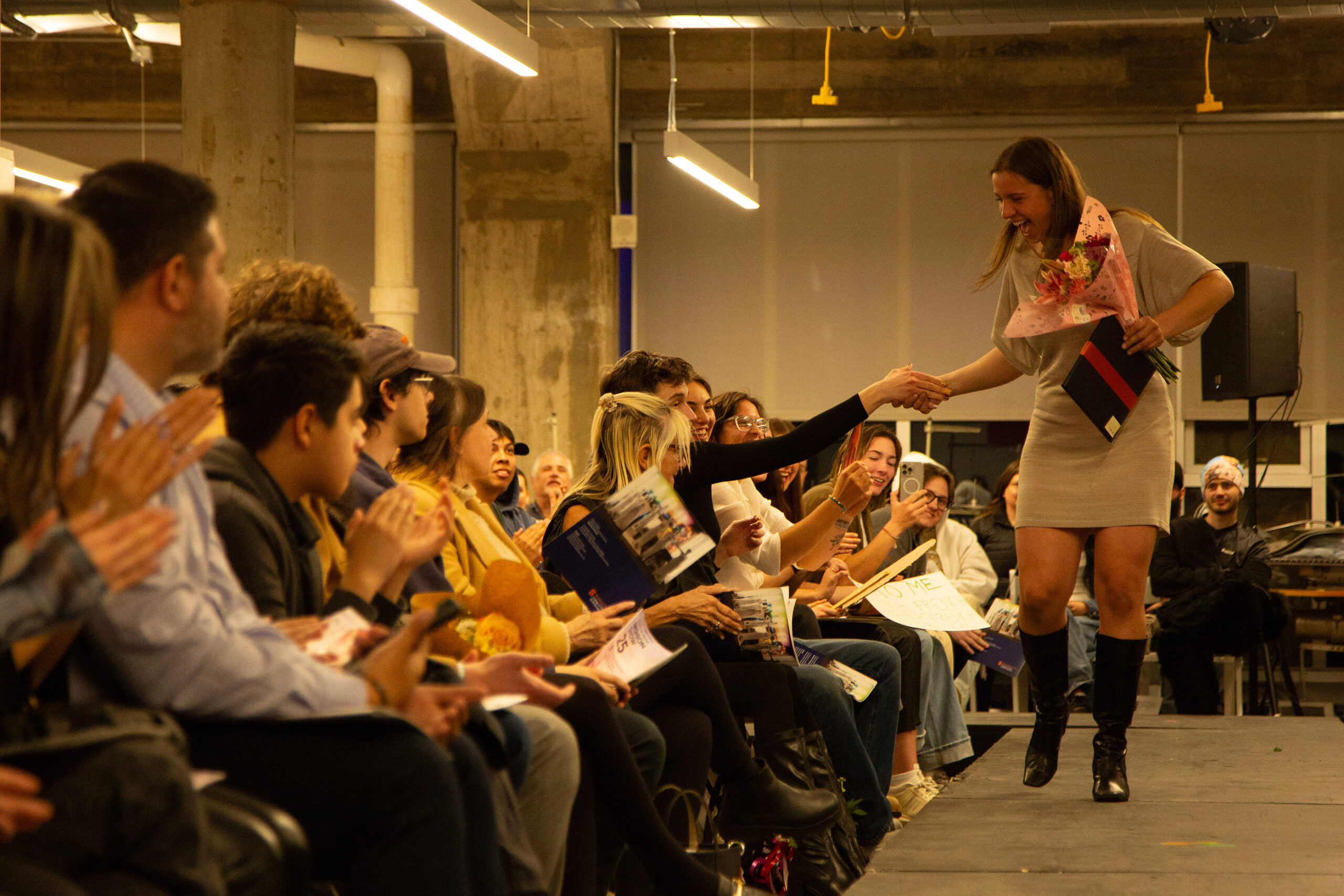Fashion design seniors flaunt creativity, inspiration at annual showcase

On Thursday, 13 Syracuse University fashion design seniors presented pieces from their senior collections at the Nancy Cantor Warehouse. Each of designer created a collection of six pieces, centered around a personal theme from their lives. Courtesy of Malcolm Taylor
Get the latest Syracuse news delivered right to your inbox.
Subscribe to our newsletter here.
Though Layla Abudayeh originally came to Syracuse University as a kinesiology and neuroscience major, she grew up in a creative family and always loved painting. After her freshman year, she honed in on her artistic skills and transferred to a fashion design major.
At first, she didn’t even know how to sew, but she found herself constantly learning new things from her professors and peers. She discovered the world of fashion, building off her background in painting.
“There was something amazing about fashion specifically, where you can take something two dimensional and make it three dimensional,” Abudayeh said.
SU’s College of Visual and Performing Arts hosted two shows this past Thursday at the Nancy Cantor Warehouse, where 13 fashion design seniors, including Abudayeh, presented pieces from their senior collections. The collections showcased designers’ personal passions and growth over their years at SU.
Each designer began with a baseline of illustrations and worked as a class to narrow down their ideas from there. At the beginning of their senior year, the class started by sketching ideas for looks in their portfolio, which evolved into a collection of 25 sketches. From those, the students each chose six pieces to craft for the show.
The entire process was led by the students, with guidance from Todd Conover, an associate professor of fashion design.
“The one thing I try not to do too much is to guide their aesthetics,” Conover said. “I want them to figure out on their own what it is they would like to accomplish, what story they’d like to tell.”
When discussing how they got to where they are today, each designer shared how artistic passion and creative outlets were cornerstones of their lives from an early age. For Morgan Hopsicker, several experiences cultivated her love of fashion, from designing clothing for pets as a child to working in boutiques in high school.
Designers Lindsay Kim and Sasha Warm shared how having artistic family members and taking art classes in high school allowed them to explore various styles and ultimately dive into creating clothing.
This class of fashion design seniors came from a variety of different backgrounds. Culture and life experiences became the driving force behind some collections, like Kim’s.
Kim drew inspiration from her Korean background and put a modern spin on traditional garments. She acted on childhood nostalgia and her love for natural landscapes to create a new style.
“Normally the colors are really vibrant and happy, and I wanted to make it a little more mature. The last time I did wear something traditional like this was when I was a kid,” Kim said.
Abudayeh’s collection centered around Metro Boomin’s album “Heroes & Villains.” She focused on bringing the visuals and motifs of the album to life through the construction of her pieces.
Hopsicker created her collection, “Red Zone,” about her love for American football. Her dad and brother both played the sport, so she wanted to combine athletic wear with high fashion.
Warm explored femininity and elegance through her fairy-tale oriented collection. She highlighted the mobility of material and how different colors and palettes can tell different stories.
“I have a lot of flowy stuff and silhouettes that you’d see in a classic fairy tale movie,” Warm said. “But then, paired with feminist subversions, I wanted to mix the fairy tale-esque with boss-feminine things.”

The 2025 class of Syracuse University fashion design seniors all come from different backgrounds and walks of life. Their personal experiences and cultures were inspiration for their senior collections that were featured at two shows at the Nancy Cantor Warehouse on Thursday. Courtesy of Malcolm Taylor
Unconventional materials and the different purposes of fashion surfaced in many collections. Designer Eleanore Jeffreys worked with recycled billboard vinyl to experiment with patterns and silhouettes.
“My process is very driven by problem solving with materials and how I can make something unconventional work,” Jeffreys said. “A lot of the silhouettes are inspired by naturally occurring patterns, things like leaf structures and microscopic bone dissections and this organic fluidity we find just occurring naturally.”
Throughout the designers’ four years of classes, students and faculty consistently discussed themes of sustainability and experimentation, Warm said. From their learnings, designers felt inspired to use unconventional materials and repurpose traditional ones. Hopsicker incorporated reused football materials like jerseys, shoulder pads and helmets into her pieces with a couture twist.
Sustainability also came into play in some of Jeffreys’ pieces, which had detachable parts that could be hung as wall art.
This showcase was one of the few times in the seniors’ emerging careers when they could have full creative autonomy, Conover said.
“It gives them an opportunity, perhaps the only opportunity in their careers, where they can actually be in control of the whole process,” Conover said. “They had none of those restraints in this experience.”
While their futures in the industry are sure to look different, the designers have core values they aspire to maintain in their work. Abudayeh and Jeffreys said they want to work with independent brands and stay away from the corporate fast fashion world.
For Warm, the pieces in her collection reflected her personal style and the sector of evening wear that she wants to break into professionally. In the future, Kim wants to build off the designs of her current collection and dive into mixing Korean styles with Western influences to create custom clothing.
Amid the array of stories presented in the showcase, Abudayeh hopes each designer’s distinct creativity shines through. The collaboration and sense of community in the program pushed the class to be where it is today. From freshman year to now, the class has learned from each other by sharing advice and insight, Kim said.
The program’s smaller size allowed for one-on-one learning with professors, where students could nurture connections and relationships, Hopsicker said. The final collections are a testament to the collaborative experiences through critiques and how the students were a part of each other’s work, Conover said.
“We need a community of creatives, as creative people, to have people around you who are continuously pushing you and just excited for the work that you’re doing,” Jeffreys said.






